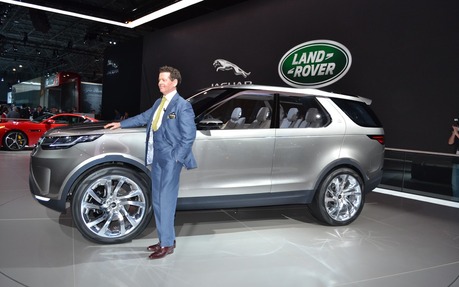The Land Rover Discovery Vision Concept: Inspiration and technology of the future
These days, it’s pretty rare that an automaker will release a concept car just for kicks or to impress the public. And that certainly wasn’t the case with Land Rover at the New York Auto Show. The brand introduced the Discovery Vision Concept, a vehicle that will define the upcoming line of Discovery models in terms of philosophy, image and style.
Functional and dynamic
For years, Land Rover has enjoyed a rich heritage of off-road capabilities. It’s what the brand is known for and has always been at the heart of its designs. But now Land Rover wants to slowly move away from this design approach while maintaining the vehicle’s personality. The Discovery Vision Concept embodies this change in philosophy by featuring more modern—and less pragmatic—lines. Key to its design is a reverse C pillar , a decision that will affect all models in the new Discovery family.
- Also: Land Rover Debuts ''See-Through'' Virtual Imaging in Discovery Vision Concept
- Also: Land Rover: New direction and new Defender model
The concept car includes various important style cues, including a stepped roof and alpine windows (made up of a glass portion and a curved section that blends into the sides of the roof). That’s classic Land Rover style. It’s also hard not to notice the 23-inch wheels that this hefty vehicle stands on.
Inside the vehicle, the environment is both ultra-modern and extremely versatile, as the modular seats can be reconfigured as needed. Positioned one behind another, the seats (including the centre seat in the second row) can be folded down and slid forward or back. A multitude of configurations is possible. One option is a limousine-style set-up with all the second row seats moved forward. Unlike other classic models, this vehicle is equipped with a one-piece hatch.
At the heart of this concept are several technological innovations intended to maximize the vehicle’s skill set. These include intelligent laser headlamps that not only emit superior luminosity but also adapt to road conditions and traffic. Another interesting feature is the so-called transparent hood. Using a system of cameras hidden in the front grille, it projects onto the windshield a view of what’s directly below the hood. It then calculates the position and angle of the front wheels to provide any other additional information that may be useful, such as in off-road conditions. Thus, front blind spots are essentially cancelled out.
This concept will serve as inspiration for the Discovery Sport, the first new model in the Discovery family.
